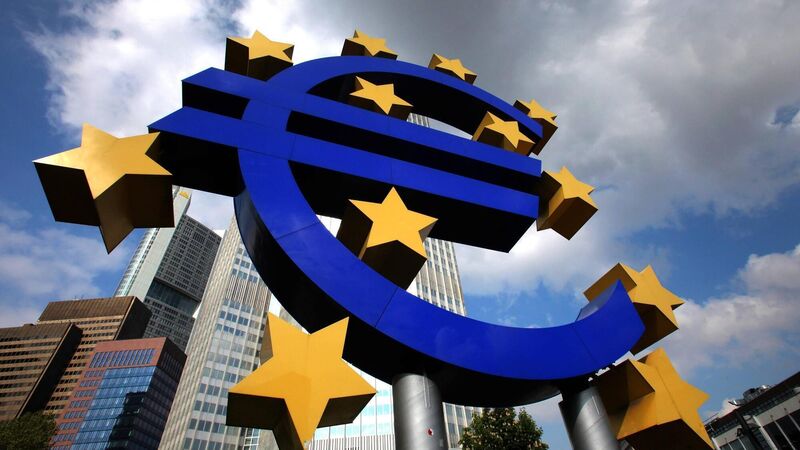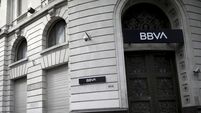Long shadow of the Fed shows limits of ECB talk of independence

Policymakers led by President Christine Lagarde have started to prepare markets for an initial cut on June 6 as price pressures ease rapidly. Photographer: Hannelore Foerster/Bloomberg via Getty Images
The European Central Bank insists it won’t take any cues from the Federal Reserve on when to start cutting interest rates — but its subsequent policy path may well be shaped by what happens in the US all the same.
Trends driving the world’s largest economy usually don’t take long to spill into other regions, impacting financing conditions and exchange rates almost immediately — and inflation, trade and other metrics further out. So policymakers elsewhere can’t really escape the Fed’s gravitational pull when assessing the fate of their own economies.
For ECB officials gathering next week to discuss when, how quickly and how much to dial back their aggressive monetary tightening, that means keeping a close eye on the US — even as they stress they’ll chart their own path.
“The ECB can absolutely move before the Fed,” said Piet Christiansen, chief strategist at Danske Bank. “Imagining policies to diverge for longer — say nine months and beyond — is more difficult, because ultimately whatever drives decisions at the Fed will spill over to Europe and affect the eurozone as well.”
Policymakers led by President Christine Lagarde have started to prepare markets for an initial cut on June 6 as price pressures ease rapidly. While they’ve pushed back forcefully against the notion they’ll want to keep in line with Fed Chair Jerome Powell, they haven’t committed to what happens after the first step, arguing that economic data will decide.
Traders are betting that the ECB will most likely deliver four cuts this year, while they are torn on whether the Fed will reduce rates two or three times after Powell reiterated Wednesday that he’s in no rush to start lowering borrowing costs.
More than two years after the start of Powell’s hiking cycle, the US economy has proved remarkably resilient, with employers still hiring workers at a robust clip. If sustained, such strength could also support the European economy, which has only narrowly avoided a recession in the winter.
“On inflation, it is too soon to say whether the recent readings represent more than just a bump,” Powell said Wednesday in a speech at Stanford University in California. “We do not expect that it will be appropriate to lower our policy rate until we have greater confidence that inflation is moving sustainably down toward 2%.”
Recent reports have shown signs of a fledgling recovery in Europe, with purchasing managers seeing growth around the corner and business confidence has picked up as well. Meantime, inflation in the 20-nation euro region slowed more than expected in March, and at 2.4% is approaching the ECB’s goal.
Bloomberg Economics predicts price increases will slow to below 2% as early as August and average just 1.4% in 2025. The ECB’s own forecast is for a rate of 2% next year.
“Having been wrong before on the breadth of cost pressure, the Governing Council will proceed cautiously as the easing cycle gets underway,” BE’s Jamie Rush wrote in a note. “But it is still reasonable to expect deep cuts to interest rates this year.” He anticipates four quarter-point steps, taking the deposit rate to 3%.
The ECB has proved in the past that it can diverge from the Fed – when it cut rates in December 2015 and again in March 2016 the US central bank was embarking on a three-year period of hikes. The Swiss National Bank has already shown the way in the current cycle, with an unexpectedly lowered borrowing costs in March, intended to prevent gains in the franc.
Economists disagree on what the overall effect would be of a divergence between the ECB and the Fed.
Some argue that a more aggressive easing for the euro area could bring greater inflationary pressures — lower borrowing costs relative to the US could weaken the single currency and pose an added risk via higher import prices.
Former ECB Chief Economist Peter Praet, however, warns that the carry-through from tighter-than-expected Fed policy might lead to more of a dampening effect on the European economy and prompt policymakers in Frankfurt to cut more than they might have otherwise.
“The risk is real that rate-cut expectations will be disappointed, resulting in tighter financial conditions worldwide,” he said. “Ultimately the ECB should not exclude the need for more aggressive rate cuts.”
Investors are already positioning for losses on the European currency. In the options market, there are twice as many contracts in the past week that are negative on the euro as there are positive, according to data from the Depository Trust & Clearing Corporation.
Some traders are betting the currency will slump to $1.05, from around $1.08 on Wednesday. Breaching that level could bring the prospect of euro-dollar parity into view for the first time since 2022.
“The ECB will ‘outdove’ not only the Fed but most other G-10 central banks,” said Valentin Marinov, head of G-10 FX strategy at Credit Agricole, citing the bloc’s weaker growth outlook and subsiding inflation.
While ECB officials may be wary of a slide in the currency, Lena Komileva, chief economist at G Plus Economics, argues that the eurozone may have to embrace one.
“If the Fed doesn’t cut soon,” she said, “then the ECB will need to cut and cut more than it would otherwise do to avoid an unnecessary recession.”
Bloomberg.










